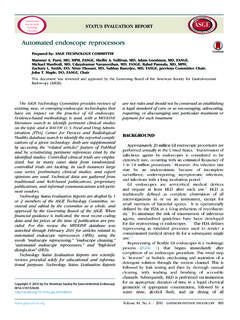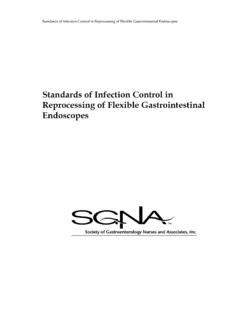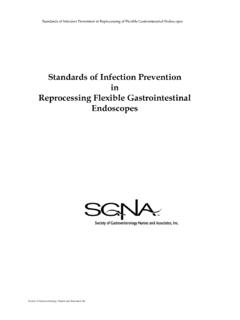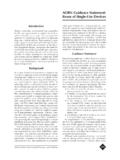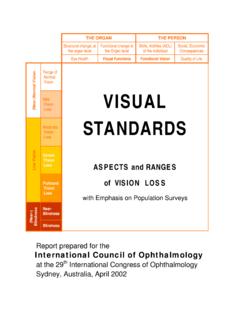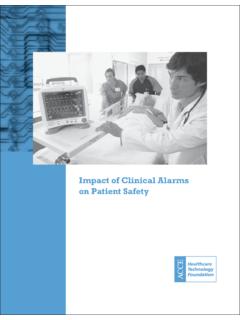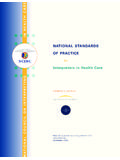Transcription of Center for Clinical Standards and Quality /Survey ...
1 DEPARTMENT OF HEALTH & HUMAN SERVICES Centers for Medicare & Medicaid Services 7500 Security Boulevard, Mail Stop C2-21-16 Baltimore, Maryland 21244-1850 Center for Clinical Standards and Quality / survey & Certification Group Ref: S&C: 14- 44-Hospital/CAH/ASC DATE: August 29, 2014 TO: State survey Agency Directors FROM: Director survey and Certification Group SUBJECT: Change in Terminology and Update of survey and Certification (S&C) Memorandum 09-55 Regarding Immediate Use Steam Sterilization (IUSS) in Surgical Settings Introduction To assist surveyors in assessing compliance of sterilization practices in surgical settings with Medicare health and safety Standards for hospitals, Critical Access Hospitals (CAHs) s and Ambulatory Surgical Centers (ASCs), we are providing an update to S&C Memorandum 09-55 regarding the use of flash sterilization.
2 In this memo we: Discuss current recommendations from nationally recognized organizations with expertise in infection prevention and control and other professional organizations to abandon the use of the term flash sterilization, which is now considered outmoded, and replace it with the term Immediate Use Steam Sterilization (IUSS), and clarify the differences between the two; and Reiterate and update information regarding nationally recognized infection control guidelines and professionally acceptable Standards of practice with respect to IUSS. Memorandum Summary . Change in Terminology: Flash Sterilization vs. IUSS: Nationally recognized organizations with expertise in infection prevention and control and instrument sterilization processes, and other professional organizations recommend abandoning the use of the term flash sterilization, which is now considered outmoded, and replacing it with the term IUSS.
3 Update of S&C Memorandum 09-55 Regarding Standards for Immediate Use Sterilization in Surgical Settings: This memo reiterates and updates information regarding nationally recognized infection prevention and control guidelines and professionally acceptable Standards of practice with respect to immediate use sterilization and supersedes S&C Memorandum 09-55. Page 2 - State survey Agency Directors Regulatory Requirements Medicare-participating hospitals, CAHs, and ASCs are subject to Conditions of Participation (CoP) or Conditions for Coverage (CfC) regarding infection prevention and control practices in surgical settings, including but not limited to: Hospitals: 42 CFR (a): The hospital must provide a sanitary environment to avoid sources and transmission of infections and communicable diseases.
4 There must be an active program for the prevention, control, and investigation of infections and communicable diseases. CAHs: 42 CFR (a)(3)(vi): CAH policies must include: A system for identifying, reporting, investigating and controlling infections and communicable diseases of patients and personnel. ASCs: 42 CFR (a): The ASC must maintain an infection control program that seeks to minimize infections and communicable (b)..The ASC must maintain an ongoing program designed to prevent, control, and investigate infections and communicable diseases. In addition, the infection control and prevention program must include documentation that the ASC has considered, selected, and implemented nationally recognized infection control Change in Terminology: Flash Sterilization vs.
5 IUSS Surgical disinfection and sterilization procedures are expected to be consistent with accepted Standards of practice to prevent the transmission of infectious disease and protect the health and safety of patients. The technology and terminology in this area can be a source of confusion when assessing sterilization procedures during surveys. IUSS was formerly known as flash sterilization. The term flash sterilization is now considered by multiple organizations nationally recognized for their expertise in infection prevention and control and sterilization practices and other professional organizations to be an outmoded term that should be replaced with the term Immediate Use Steam Sterilization (IUSS).
6 These organizations have also recently described professionally acceptable Standards of practice with respect to the use of IUSS. Background Information: Flash Sterilization vs. IUSS Surgical instruments must ordinarily be sterilized using terminal sterilization cycles within rigid sterilization containers, wrappers, or primary packaging designed to maintain the instruments sterility and which allow the devices to be stored for later use ( terminal sterilization ). Flash sterilization is a term that was traditionally used to describe steam sterilization cycles where medical instruments and devices: are generally not packaged in preparation for sterilization; are subjected to an abbreviated steam exposure time and no or minimal drying time; and are used promptly ( , without being stored).
7 Page 3 - State survey Agency Directors A 2011 position paper1 adopted by the Association for the Advancement of Medical Instrumentation (AAMI), Accreditation Association for Ambulatory Health Care (AAAHC), Association of periOperative Registered Nurses (AORN), Association for Professionals in Infection Control and Epidemiology (APIC), ASC Quality Collaboration, Association of Surgical Technologists (AST), and International Association of Healthcare Central Service Materiel Management (IAHCSMM) ( Position Paper ) recommended that the term flash sterilization be abandoned and replaced by the term IUSS. The new term, IUSS, is still used to describe the process for steam sterilizing an instrument that is needed immediately, not intended to be stored for later use, and which allows for minimal or no drying after the sterilization cycle.
8 2 IUSS is now the preferred term, because flash does not adequately convey the fact that sufficient time and a number of steps and safeguards are required to accomplish pre-cleaning procedures that are necessary to ensure sterilization. The old terminology is also not necessarily consistent with current recommendations for the length of cycles needed for IUSS and/or the need to use rigid sterilization containers designed specifically for ,4 It should be noted that IUSS is not equivalent to short cycle sterilization. Regardless of the cycle duration, correct use of a sterilization cycle for a wrapped/contained load that meets the device manufacturer s instructions for use (IFU) is the equivalent of terminal sterilization and is not IUSS if it includes use of a dry time and is packaged in a wrap or rigid sterilization container intended to be stored for later use.
9 Professionally Accepted IUSS Standards of Practice Consistent with Standards of practice previously articulated by national associations with expertise in infection prevention, the availability of IUSS is not considered an appropriate substitute for maintaining a sufficient inventory of ,6,7,8 While IUSS will accomplish sterilization if all of the steps before, during, and after the process are performed correctly, and used in compliance with specific device manufacturer s; sterilization manufacturer s; and, if applicable, container manufacturer s validated written instructions for use (IFU). Practices associated with the outmoded term flash sterilization have been implicated in surgical site infections and are considered to pose an increased risk of complications because of potential barriers to thorough completion of all necessary reprocessing ,10,11,12,13 IUSS also entails an increased risk of inadvertent contamination during transfer to the sterile field and damage to the instruments,14 a s well as risks related to wet instruments and the potential for Therefore use of IUSS, even when all steps are performed properly, should be limited to situations in which there is an urgent need and insufficient time to process an instrument by using terminal.
10 17 The Position Paper and/or the other nationally recognized sources referenced below describe the following professionally accepted Standards for the use of IUSS: The Position Paper emphasizes that [c]leaning, decontamination, and rinsing are critical and users must follow and complete all required processing steps regardless of the sterilization exposure parameters being used. 18,19,20 Page 4 - State survey Agency Directors The same multistep process used to prepare the instrument for terminal sterilization must be completed for Cleaning must be performed in an area that has all of the equipment ( sinks and mechanical and/or ultrasonic washers), cleaning agents, tools ( brushes), water Quality and availability of information needed to follow the medical device manufacturer s IFU regarding both cleaning and The parameters (exposure time, temperature, and drying times [if any drying is recommended]) of an IUSS cycle must be determined after reviewing the IFUs for each of the following.

